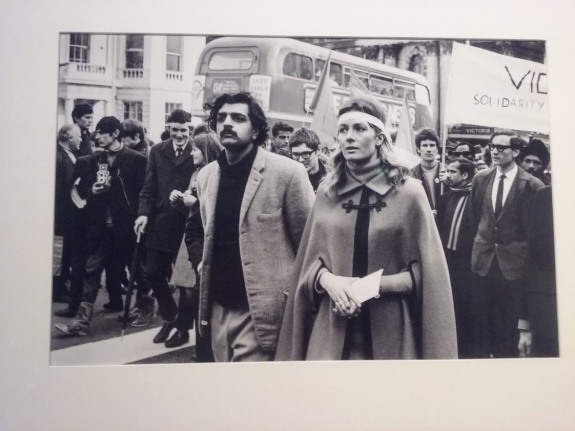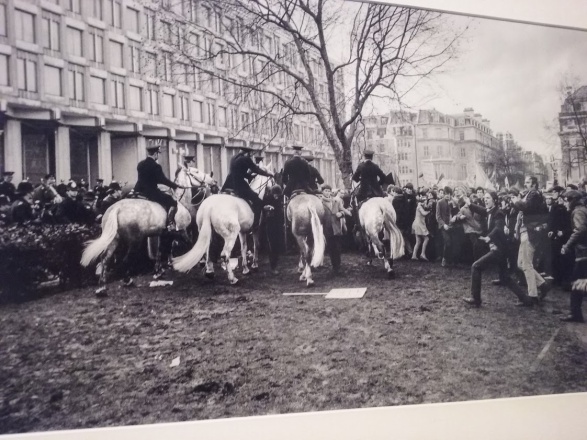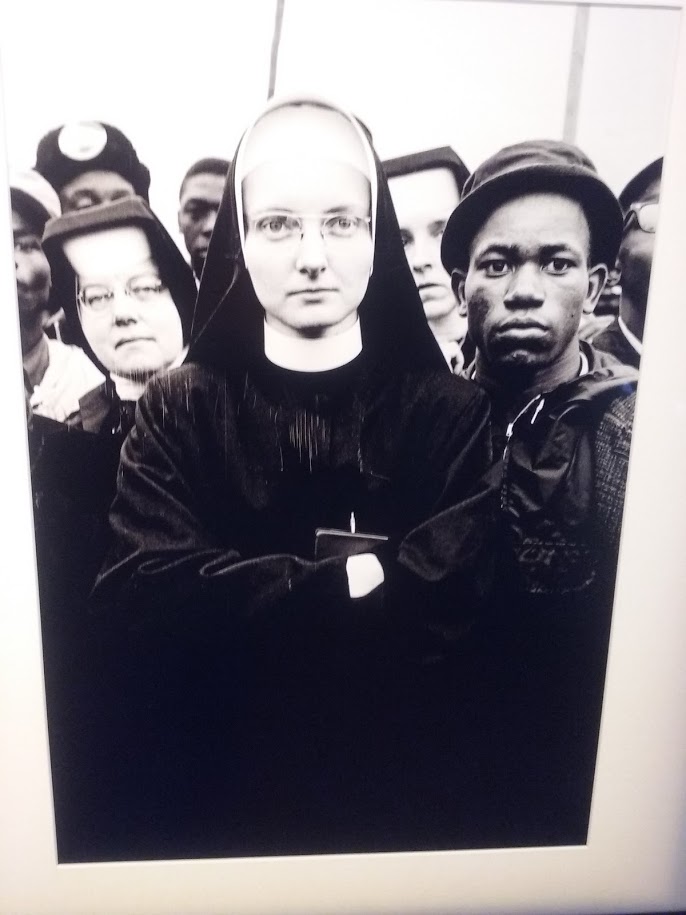Photography Exhibition
This exhibition is located in Temple Bar, in Dublin’s Gallery Of Photography. A collection of black and white photos and news items has been collated by Tony McGrath. The function is to document Civil Rights movements of the 1960s. He seeks to show how global movements mirrored and inspired one another. The culmination of the exhibition is coverage of Northern Ireland. He calls the collection The Lost Moment.
Whereas in America we see the initial offerings covering black civil rights, and the rest of the gallery shows white faces, otherwise I found many similarities. In all cases one group of people felt impelled to protest in public, and the authorities of the day responded by sending police and sometimes soldiers to control their movements.

Initially we see Alabama in 1965, taken by Steve Schapiro. A striking image is a young white nun beside an older black workman. Other images show Martin Luther King, as the Reverend addresses crowds, including many women. We can see a camera recording the moment. The black people had no wealth or power and while we do not see any evidence of discrimination we are expected to know about black people sitting at the back of the bus, using separate restrooms, working in menial tasks for low pay, getting separate education. The police are all male. The impression I got was of stoicism and bitterness.

On the adjacent wall we see London in 1968 as people protest against US military involvement in Vietnam. A few well known faces are in one central photo by David Hurn; Vanessa Redgrave, actress, Tariq Ali, socialist (a model for Citizen Smith of the BBC comedy show) and walking behind them, Stephen Hawking, scientist.

I noticed that here the police are again all male and police horses are employed, with no protection for the horses’ eyes. Double bridles were used, so the riders are controlling two reins per hand. A photo scene seemed almost composed with a central shot of two sides clashing, a leafless tree (a London Plane, Platanus × acerifolia) in the middle and elegant buildings in the background. This looked like a Renaissance painting. Other photos chose to zoom in on faces. These scenes looked to be showing loud, dramatic protest, not peaceful marches.

Prague in 1968 had been invaded by Russian forces. All foreign media were expelled but Ian Berry was the only Western photographer to remain. He showed us popular protest against the invasion in Prague streets. One shot really captures a split second as a youth runs from an armed soldier. The young man’s feet are off the cobblestones and the scene is one of drama and motion. Here I noticed an atmosphere of quiet desperation.
From here we move to a gallery room featuring Northern Ireland. As someone who grew up with Troubles on the news every night I have a different reaction to these images than a modern teen or a tourist. The context is different for me. Tony McGrath has documented the Civil Rights movement in Derry. Again we see an all male police force, in dark uniforms but no modern riot protective gear. Crowds are mainly male but some women are present, often noticed by a short skirt or bright coat. A very strong image is a woman at home in a basic tenement house putting her children to bed; this reminded me of the iconic image Migrant Mother by Dorothea Lange.
Moving on we see a march between towns in 1969 photographed by David Newell Smith, out in the countryside. Unkempt hedgerows and hillsides are the setting for a large march, the male police all wearing hats, protesters largely bareheaded, some with flat caps. A few women attend.
A copy of The Black Dwarf magazine on the wall, edited by Tariq Ali, shows a quote from Malcolm X about revolutions changing corrupt society, and a Guinness bottle made into a Molotov. This was from August 1969.
Montage of images; police, protesters and children
The views change to show escalation of drama, attack and counterattack, so we clearly follow the narrative as the Troubles proper begin. Media crew are photographed by Barney McGonagle; Clive Limpkin focuses on riots in Derry, 12 – 24 August 1969. Barbed wire and military presence of B-Specials have replaced earlier genial police. A poster says “Meme les enfants participant a la boutaile.” This shows French media covering a photo of women and children stuffing oily rags into the mouths of petrol-filled bottles in a determined group. This made me think of similarities to the French Revolution, also called The Terror. We then realise that authority figures are terrified of popular revolution, even if heads would not literally roll this time. But no politicians or famous figures appear, apart from Rev. Paisley; only those who would become famous, Bernadette Devlin for instance. Nowadays we call such people activists, but that word was not in circulation.
I thought the display worked well to show the progress of people’s movements against injustices of the day, building upon one another and sadly turning to violence by the end of the 1960s. The popular environmentalist movement in America (as distinct from the wealthy preserving their leisure space) similarly began with Greenpeace, then a group of mainly Quakers, bearing silent witness to nuclear testing, and escalated to dramatic protests and banners designed to catch the media’s attention, followed by eco-activists spiking trees ahead of logging operations. More information here.
A great many vivid images were displayed in a compact space, the black and white making the emotions more vivid, the juxtapositions more striking. Once the news of the day has moved on, people could easily forget these photos, which may be considered works of art in themselves. The curator has also imposed his own view of the topic by choosing not to include pontificating politicians. I noticed that no women photographers were included; maybe there were not many at the time, or maybe they were not sent to cover conflict.
Roland Barthes said: “The birth of the reader must be at the cost of the death of the author.” (1967) While he was discussing books, I believe the same can be applied to photographs. The photographer cannot come around explaining what he/she wanted to capture in a shot, what time of day it was or why they picked one shot out of the many rolls of film. Each viewer must form their own individual view of a photo or the collection of photos, and the life experiences or political leanings of the viewer may flavour their appreciation of the collection The Lost Moment.




